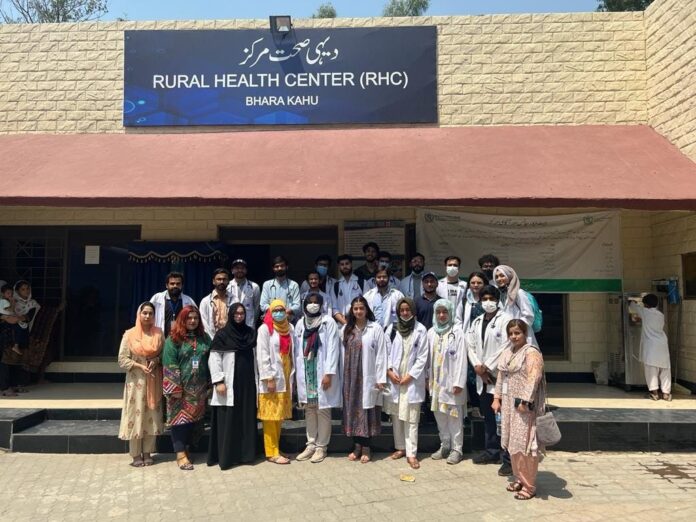By Atif Ismail
MULTAN, Feb 23 (APP):: After economic sustainability, health and education sectors always remain of utmost importance when it comes to delivery of basic amenities to people in almost every developed country of the world.
But, in many countries of African and Asian continents, it still remain a far cry for people living in remote and rural areas and Pakistan is also not an exception where many areas still lag behind in these facilities.
South Punjab is one of the examples, where over 60% of the population living in villages and small towns had least access to quality healthcare for hospitals being less-equipped, specialist doctors falling short of requirement and primary healthcare facilities being inadequate.
Rural communities had been struggling with preventable diseases, maternal health complications and poor child nutrition and absence of sufficient healthcare at their doorsteps forcing many to travel long distances to urban hospitals. Poverty and lack of awareness were the other factors making even basic medical treatment unaffordable for a large segment of society.
But, the things started changing recently when the present Punjab Government led by Maryam Nawaz Sharif took on the challenge of providing healthcare to even remote areas by equipping hospitals, infrastructure improvement, increasing staff in these areas and launching mobile health services. Vaccination drives and awareness campaigns are the other efforts on ground.
“We are on it. Our government keeps health sector on top priority. Clinics and hospitals are being equipped with modern health facilities,” were the remarks of Provincial Minister for Health Imran Nazir during his visit to Maryam Nawaz Health Clinic in Qasim Bela.
“Maryam Nawaz Clinics were a revolutionary initiative by the Chief Minister Punjab. These clinics are equipped with modern medical facilities and advanced healthcare tools,” the minister had stated.
Explaining further, he had informed, “the Clinics feature a fully digital system from patients’ entry to treatment. Citizens can access these clinics round the clock as 21 Maryam Nawaz Health Centers were being upgraded in Multan division.”
Although, according to data available with South Punjab Secretariat, there are nine DHQs, 35 THQs, three Town Hospital, 122 Rural Health Centre, three Civil Hospital, 761 Basic Health Units, two Trauma Centre, one Eye Hospital, three Maternity Hospital, Seven TB Clinics, 75 MCH Centers, 380 Dispensaries and 17 CMC Centers, yet the facilities were short of masses needs living in the region with many facilities facing human resource shortage.
Now 188 more clinics are being set up and health experts like Dr Jabran, Coordinator Integrated Reproductive Maternal Newborn Child Health (IRMNCH) terms it as a revolutionary steps to ensure health facilities to people especially living in “Kachi-Abadis” and remote areas.
He informed that initially, three BHUs were outsourced for improving the health facilities in three different locations. “The doctors have been tasked to examine at least 900 patients per month along with provision of medicines and the government is offering Rs 400 against every patient.”
He said the government is also installing solar systems and providing residences to support the holders of BHUs. “This step is ensuring 24/7 availability of doctors for local communities and after its success the initiative would be expanded to 82 BHUs in district Multan and each outsourced unit will also manage 20 delivery cases every month.”
Dr Jabran also mentioned to ‘Clinic on Wheels’ initiative under which eight vehicles along with doctors visit eight different union councils on daily basis and treat people. “The government is planning to purchase much more vehicles to expand this program across the province.”
Similarly, he said, one field hospital is also operational in the district. “A bus carrying modern diagnostic machinery and medical experts also visit different areas; medicines are offered to ailing people and serious patients are shifted to hospital on doctors’ recommendation.”
Now, after a long time, revamping of BHUs and RHCs is also in progress in South Punjab and the hospitals are being upgraded with improved facilities and infrastructure.
The initiative of “Big Catcher” is also progressing effectively as kids earlier neglected in vaccination campaigns are now traced in every union council by a team of five officials and vaccinated.
Besides introducing 32 field hospitals across province, the Punjab government is also on toes for making initiatives like Hepatitis Control, TB Control, Infectious Control Program and other programs, a success.
Heaping praise on health initiatives, Madeeha Qureshi, a patient at Nawabpur village remarked that it is for the first time that health facilities are being upgraded in remote villages. “It is a good sign and we hope it would surely facilitate the people. I myself got checked my minor daughter locally that saved my time and money.”
Salman Amjid, another citizen, also lauded the reforms in health sector saying, “I was suffering from cough and flu due to a viral infection. The newly set up ‘Clinic on Wheels’ treated me well and now I am in good health and like this initiative.”
With the Punjab government already setting new examples in serving the masses, such welfare initiatives must be consistent and for a longer period to rid poor people in remote areas from problems confronting them since decades.
APP/atf/maz (APP Feature Service)

